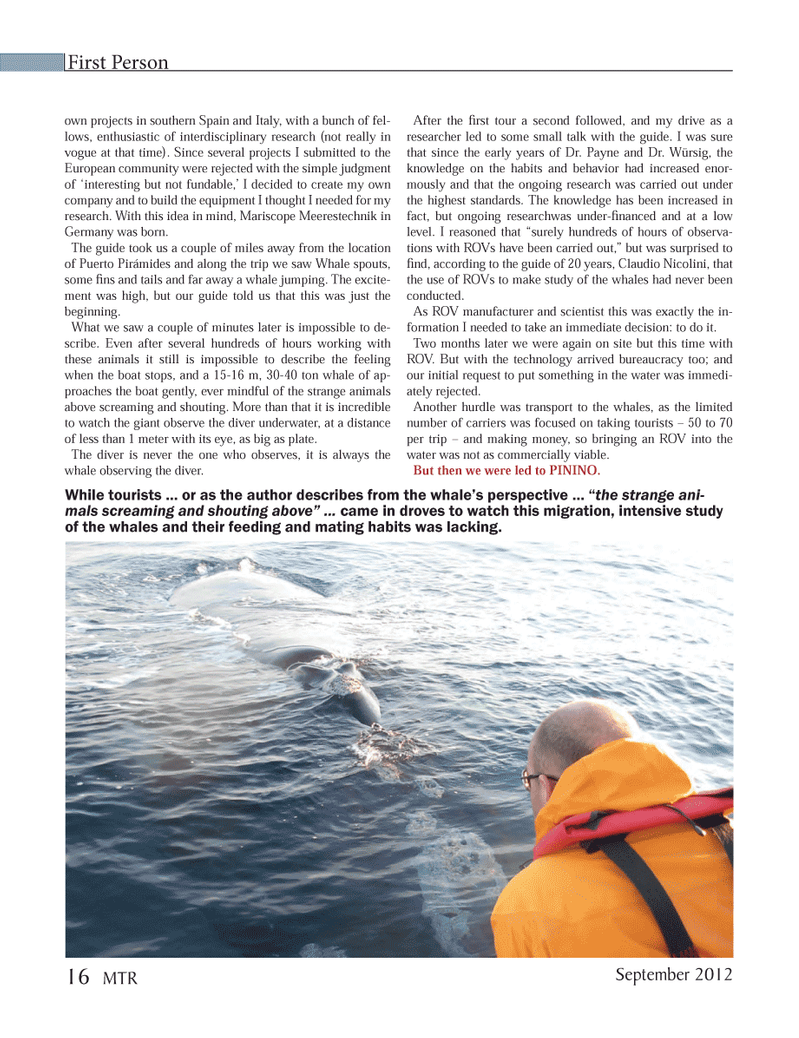
Page 16: of Marine Technology Magazine (September 2012)
Subsea Defense: Protecting Port & Subsea
Read this page in Pdf, Flash or Html5 edition of September 2012 Marine Technology Magazine
own projects in southern Spain and Italy, with a bunch of fel- lows, enthusiastic of interdisciplinary research (not really in vogue at that time). Since several projects I submitted to the European community were rejected with the simple judgment of ?interesting but not fundable,? I decided to create my own company and to build the equipment I thought I needed for my research. With this idea in mind, Mariscope Meerestechnik in Germany was born. The guide took us a couple of miles away from the location of Puerto Pirámides and along the trip we saw Whale spouts, some ns and tails and far away a whale jumping. The excite- ment was high, but our guide told us that this was just the beginning. What we saw a couple of minutes later is impossible to de- scribe. Even after several hundreds of hours working with these animals it still is impossible to describe the feeling when the boat stops, and a 15-16 m, 30-40 ton whale of ap-proaches the boat gently, ever mindful of the strange animals above screaming and shouting. More than that it is incredible to watch the giant observe the diver underwater, at a distance of less than 1 meter with its eye, as big as plate. The diver is never the one who observes, it is always the whale observing the diver. After the rst tour a second followed, and my drive as a researcher led to some small talk with the guide. I was sure that since the early years of Dr. Payne and Dr. Würsig, the knowledge on the habits and behavior had increased enor- mously and that the ongoing research was carried out under the highest standards. The knowledge has been increased in fact, but ongoing researchwas under- nanced and at a low level. I reasoned that ?surely hundreds of hours of observa- tions with ROVs have been carried out,? but was surprised to nd, according to the guide of 20 years, Claudio Nicolini, that the use of ROVs to make study of the whales had never been conducted.As ROV manufacturer and scientist this was exactly the in- formation I needed to take an immediate decision: to do it. Two months later we were again on site but this time with ROV. But with the technology arrived bureaucracy too; and our initial request to put something in the water was immedi- ately rejected.Another hurdle was transport to the whales, as the limited number of carriers was focused on taking tourists ? 50 to 70 per trip ? and making money, so bringing an ROV into the water was not as commercially viable. But then we were led to PININO. First Person While tourists ... or as the author describes from the whale?s perspective ... ? the strange ani-mals screaming and shouting above? ... came in droves to watch this migration, intensive study of the whales and their feeding and mating habits was lacking. September 201216 MTRMTR #7 (1-17).indd 16MTR #7 (1-17).indd 169/10/2012 11:57:38 AM9/10/2012 11:57:38 AM

 15
15

 17
17
